3rd December 2024: A Journey Round a Virtual M25 in the 1960s - David Cross
We were very pleased to welcome David, who once again called with a selection of his late father Derek’s photographs. This time it was slides and a tour following the route of the M25 around London. There was of course only the recently opened M1 when Derek was there with his camera so we were shown some great shots of the Northants section of the M1 with steam expresses rushing by and virtually no traffic on the embryonic motorway.
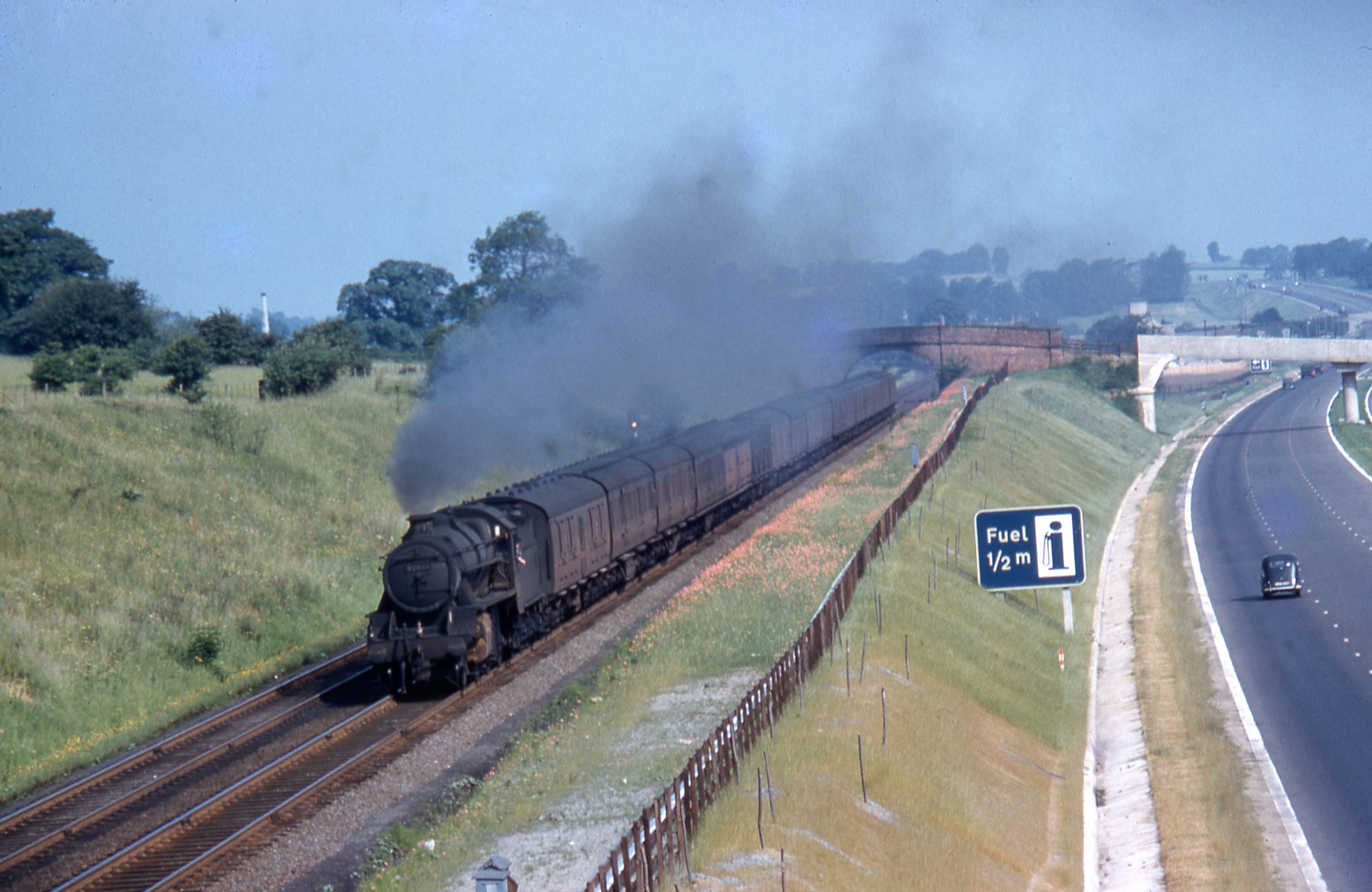
Back in June 1960 there was no M25, just the newly opened M1 with grass verge and little traffic - and at Weedon, Derek Cross captured Stanier mogul 42951 on an up parcels train on the adjacent West Coast Main Line.
How grateful we are to the likes of David and others like Michael Clemens who go round the country with their late father’s photos, and also often generously offering copies or timetables and ticket printouts to lesser mortals like me who can borrow or buy them for talks. Others like Hugh Davies continue to maintain their photo libraries with help. So many collections have been broken up and sold and then seem to disappear or re-emerge at vast expense.
We began in west London with the premier line of the GWR to the west featuring green engines with trains running through tidy cuttings with an absence of scrub trees and lineside rubbish. The Paddington view featured county relegated to ECS or steam heating. Out in the country Sonning looked splendid with attendant expresses. As the photos were from 1958 to 1988, we saw Westerns in action and even a short-lived “Teddy Bear” on the mainline, but on pilot duty. A great set of images showing WR expresses in all their steam and early diesel glory.
On the SR we were treated to malachite green locos on express duty, with EMU’s thrown in as we remember things. A reminder of things past was a short train arriving at Worting Junction including supplies of coal and water for the bobby. Old bird cage carriages and compressed air signals featured with cl 33’s on Exeter trains. We saw W class 2-6-4T 31924 in Feltham yard, an unusual shot. Panniers blasting up Folkestone incline. A reminder too of Bedford excursions, in this case to Margate with a Black 5. A great mix of new and old diesel/third rail and glorious steam.
Turning to the ER, David showed many shots of the route out of King’s Cross when it was visibly clean and tidy, with views of famous stretches and glorious tunnels graced with splendid engines - A4s and Deltics hauling what looked like monster trains. I think we could smell the Ayot rubbish train behind an N2. Finally ending with a great shot of Welwyn Viaduct in its naked glory.
Finally the LM region turned up, with Stanier Pacifics powering expresses alongside the M1 with its minimal traffic of about 1960. That red livery always looks stunning on Duchesses, and there was even a pannier on an LT train to show diversity.
Well we hope he can find some more to entertain us again. Thank you David.
5th November 2024: A Broad-Gauge Journey, Part 1 ‘London to Swindon’ - Rev Canon Brian Arman.
Following in the great tradition of the pairing of clergy and railways (though it was the gaitered bishop who actually got to drive the engine in The Titfield Thunderbolt) we welcomed Rev Canon Brian Arman to Bedford. Someone who has spent a lifetime in holy orders he gave of course a masterful “sermon” on his favourite subject taking as his text for the evening service “Thought shalt have the broad gauge and no other gauge save that”. He demonstrated a mastery of the topic taking us on an entirely broad-gauge journey from Paddington to Swindon as Part one of his story. Delivered without notes in a clear voice, like all the best sermons, he enlightened us, even if we were delusioned enough to think we knew about the topic. I came away thirsting for more. The photographs, all amazing and unrestored, had come from a multitude of sources even one discovered on a glass plate negative in the Bodleian Library. How did the early photographers manage so well with their heavy equipment but manage they did, and we pored over the results led by our superb guide.
It was another reverend, Keeble Martin, who toured Britain by train collecting and drawing flowers for his great work. He became known as God’s botanist. No doubt Brian has also travelled the length of at least former Boad gauge territory doing his research, so I wonder what title awaits Rev Brian. We started at Paddington in about 1843 with a look at this still elegant building spacious and airy. We soon got to see Mr Gooch’s masterpieces ready to gallop west with their large fireboxes and open footplate - some task to operate at 60 MPH or even a bit more, but the superb ride of 7ft gauge must have helped keep the crew on the footplate. Each train of that period was fitted up with an early form of emergency chord connected by string to the loco whistle and we also saw “the porters coffin” arrangement on the end of the loco tender looking back along the train watching for a parting. Brian in his research has left no stone unturned in unravelling stories about early C19 photographs where there is no one to tell the tale, such as early pictures of engines involved in royal or empire duties where flags reveal much of the story.
A picture of narrow- and broad-gauge locomotives side by side was taken in May 1892 to commemorate the last Broad-gauge departure from Paddington heading to Plymouth and Penzance. Part of the London underground was also broad gauge, from Paddington to Farringdon and Moorgate. One solution to steam and smoke on the underground was “Fowler's Ghost”, which attempted to use heated fire bricks but managed gaspingly but a few miles. Even Victoria had a bit of the broad gauge.
Out in the country to Slough and Windsor we travelled but our speaker regretted that only a cartoon seems to have survived of the royal train at Windsor. The delightful pictures kept coming including an excellent shot of vintage platelayers.
There was much to amuse, so the Broad-gauge story as presented was never dry and dusty as we imagined these steeds of yore pounding through Sonning Cutting or whistling through Slough. Except a so-called speeding locomotive with plume of steam was an early example of “Photoshop” so there is nothing new.
It is hard to visualise the rural nature of much of the GW main line but Pangbourne looked fabulous in another picture. After a brief run to Oxford, we finished our journey in Swindon where all change was required for loos and tea. We await eagerly for part two in 2025. (CHJ).
1st October 2024: Thomas Brassey and his work - David Hunt.
Branch members and friends were well entertained by David on railway engineer emeritus Thomas Brassey, a friend of Brunel and Stephenson. Why has this man passed us by? Was he the greatest railway builder ever? Very few countries did not come under his influence. David was anxious to inform us, to make sure he is not forgotten. An excursion into railway line and infrastructure construction is a subject area we do not seem to cover.
It seemed Brassey made good everything in railway construction that others who came before him might not have got right. His output was prolific and his main time was the 1840s to 60s at a time of great railway construction, though his first project was a trunk Road near Chester. Later in his early days it was gravity railways down to canals. He was widely involved in quarrying and stone and was credited with inventing pallets to move heavy weights.
His business growth was phenomenal and in the 1850’s he was employing 80,000 men, something of a record in the construction industry and far more than McAlpines. On railways his main forte was bridges and tunnels so his achievements include Chirk and Welwyn railway bridges as well as Colwall tunnel and many others. David pointed out that Brassey also constructed locomotives at his factory in Birkenhead. He was also responsible for non-railway engineering projecta such as Greenock and Birkenhead docks, also the magnificent Westminster embankment with its associated links to the London sewer project so he was also involved in sparing London eventually from any more of the great stink of 1865.
His enterprise far from Britain’s shores covered railways around the world with projects reported on in India, South America and Australia. This included a vast project in Canada, “The Grand Trunk Railway” which included the world’s then longest railway bridge much of it tubular like the Brittania Bridge to Anglesey, something he also recommended.
Much of what his company made came from his factory in Birkenhead, manufacturing all the parts rather like an early version of Ikea where flat packs were sent worldwide and always fitted.
David had researched all the lifetime achievements of Mr Brassey and the man as a person who cared about his family and his men. How he found time to do all of this was amazing. Including walking from project to project, travelling the world by ship and working at the same time then writing copious letters to all and sundry. It of course did not help his general health but when he died on 8th December 1870 aged 70, some 4,000 navies came to his funeral and that makes a lot of sandwiches and tea. He is commemorated in books and publications. There is also a Thomas Brassey Society who are trying to get a statue together and “Rail 200” might give this a boost. In answer to a question from the floor about a blue plaque, sadly there isn’t one.
Thank you David and we hope this report is widely read so he can deliver the talk in many places. Contact via Bedford branch. (CHJ 04/10/24)
3rd September 2024: The Railways of Devon and Cornwall - Michael Clemens
The branch was once again richly entertained, when Michael presented more of his late father’s amazing collection of brilliant quality mostly B and W pictures with some colour, all from the early 1950s or 60s.
Tonight, we found ourselves in the west country but later on firmly in the Land of Lyoness in Fair Cornwall. We began in Devon on the Taunton to Barnstable and down to Tiverton to see the “Tivey bumper”. Expresses were seen rattling through the junction. Down to the delightful set up at Hemyock. Can we see the light yes provided there was a run up the main line to charge up the coach batteries Down deeper into Devon via Exeter with a brief Lyme Regis trip out of county and onto Seaton and other branches. Mr Bulleid’s products were very prominent to Exeter Central. Good to see Ws earning their keep at Exeter. At Barnstable Junction we were shown the broad gauge shed entrance before local scenes of a special heading for Ilfracombe.
From the north coast we travelled down to down to Torrington on what is now a cycleway but was devoted to China clay. At Halwill Junction a steam roadroller was encountered in the days when County Councils owned such machines.
Via Oakhampton and off to the sea with Bude and its deserted 1960’s terminus but a T9 appears. Even the Bude canal branch was covered and a rare treat that is and what a rural transport idyl it must have been with even the little photographed narrow-gauge section by the dock and ship canal on film.
On to Launceston and its mixed-up arrangements between WR and SR no wonder it was rationalised soon after. Off further into deepest devon to Tavistock and then via Bodmin and into Cornwall onto the Newquay branch via St Denys Junction and Roch. Travelling to Helston and on finally to Penzance by main line and a little further to see the end of the Newlyn narrow gauge set up and plinthed loco. Large groups of tweed clad males accompanied our journeying.
Coverage after the break mirrored the first half with movie coverage of many of the routes seen in the first half and all converted to a high standard onto DVD from the original 8MM. A great run along the Cornish main line behind Bulleid pacific “Salisbury” to Penzance.
We went down the Chacewater branch and Port of Parr where even a steam crane was in use in the 1970s. Oh those carefree days when ports were open to visitors with cameras. Followed by a trip down the Helston branch showing how scenic it was and therefore why preservationists are busy reopening parts of it and long-lost days when you could record the journey from the train window, see where you were going and not get hit by a tree.
Michael works extremely hard on presenting all his father’s collection and is to be congratulated on the quality of the presentation. This is also an opportunity to thank him for all the material he puts on his web site for us to use. (BC)
2nd July 2024: Real Steam, Here, There & Everywhere - David Scudamore.
This was a real treat for the branch, as it was taken on a two-hour tour of the world. The main part of the illustrated talk was devoted to photographs taken during the late ninety fifties and early sixties. The remarkable thing was the clarity of the early photos which were taken on Kodak Brownie cameras. The tour started with David's very first Kodak Brownie railway photograph, an A4 on Gateshead shed, followed by views of Cambridge shed then on to China. How many locations were visited I was not sure, I think about 120, we certainly hopped around the world.
Among the places visited in the UK were: Leeds Neville Hill with 2-6-4 Tanks on local services; Nine Elms shed on 31/1/65 showing 34051 being prepared for Sir Winston Churchill’s Funeral train; Deeley 0-4-0 tank 41531 at Barrow Hill on 20/5/62; a U class 2-6-0 at Guildford; and Redhill shed on 25/7/64 with a Canklow B1 61313. We saw Q1 33006 at Gosport hauling an LCGB railtour on 19/3/66, andUSA tanks 30064 and 30073 at Southampton Docks. David even captured artist Sir David Shepherd and easel painting IOW No 17 ‘Seaview’ on Ryde shed on the last day of steam working on 31/12/66. Local views of Wellingborough, Bedford and Bletchley bought back local memories to the audience. Views of Eastbourne, Woodford Halse, Oxford and Banbury were shown. The sad end for steam in Britain was not neglected with views of scrapyards at Barry and Cashmore’s Great Bridge.
Scotland was not forgotten, Ayr shed, St Margarets, Dalry Road and Haymarket were visited. A brief visit was also made to the Isle of Man in July 1968.
Industrial steam featured with visits to the Welsh Methil & Lady Victoria Collieries. In England, Hatfield and Ashington Collieries were shown.
Overseas many countries were covered, David has been to China eleven times! We were treated to class 231 Pacific’s double headed on the “Fleche D’Or” at Amiens on 18/5/64. A line of five 282F (2-8-2+2-8-2) Garratt’s at Tarragona South Shed. Streamlined RENFE 241F2103 4-8-2 MTM Barcelona 1939. at Miranda de Ebro on 23/9/68. Also steam in East Germany, India and of course China. Amazing shots were seen in North America, including Union Pacific Challenger No 3958 (4-6-6-4) and Big Boy No 4023 (4-8-8-4) at Cheyenne, Wyoming Shed on 13/12/69. In South America, El Salvador F de ES 6 (4-6-0) built Burnham Wiliams 14824/May 1896 at Sonsonate on 25/11/69. Europe included Norway and Denmark. We also visited Africa. It was nice to see engines working on scheduled trains around all parts of the globe rather than on Railtours. The evening passed all too quickly. The Branch is very grateful to David, who stood in at one months’ notice for the advertised speaker who unfortunately could not attend, for a well-illustrated and verry knowledgeable tour of world steam. The branch will certainly ask David back for more.
(Geoff Kingham)
4th June 2024: The Midland Heads for Wales, Part 1 Hereford–Brecon - Chris Jones
Chris took as his topic the Midland Railway’s advance to Swansea, following on from his talk on the Central Wales Line, and how the LNWR got to Swansea in 1873. The Great Western Railway was already there after its take over of the South Wales Railway (which had opened the first line to Swansea in 1850). Finally the Midland Railway, not wanting to be left out of the "Dash for Swansea", took the hard way, via running powers, takeovers, even renting shed space and almost entirely single line working.
The story began in Hereford where the Midland arrived by running powers to find the Hereford, Hay and Brecon Railway ripe for a takeover. Chris explained the complex arrangements at Hereford and the various loops and link lines culminating in 1893 with at last MR trains running into the GWR Barrs Court Station leading to the closure of the bleak Moorfields and the attractive Barton. We then journeyed on towards Hay, our trip being enlivened with superb photos from the late Alan Jarvis collection loaned by the SLS. Chris thanked the many organisations and individuals who had helped him with his research.
The line to Brecon carried considerable freight and was at its zenith around the time of WW1. The four interchanges at Eardisley, Hay, Three Cocks and Tallylyn added to the bustle and activity on the line and all were illustrated in the pictures which included ones loaned by Oakwood press. The websites of Glasbury and Talgarth villages had also produced some real gems of photos to add to the interest. The through carriage arrangements were noted but it was agreed that there was never a through coach from St Pancras...
The Dowlais tanks were not missed as Mr Jarvis was on hand to record their passing. This traffic helped the line greatly in the late 50’s early 60’s but was not enough to save it. It also seemed that WR acquisition of former LMS lines was a death sentence. This was a fate that should have befallen the Central Wales line, except that under a Labour Government it ran through three marginal seats.
After a thorough exploration of the complex arrangements at Talyllyn we went on through the tunnel to Brecon and finished up with two extra items. Firstly, some Peter Handford audio, recorded on a train to Brecon which featured the immortal shout out of “Talyllyn” - remember when station names used to be called out by porters with regional accents - and, finally, the TWW film of a trip in 1962 on the line was shown with the reporter (Gordon Tucker) settled comfortably in apparent luxury first class seat.
A first class talk so we await Part 2, to take us on from Brecon to Swansea.
7th May 2024: Shildon–Stockton: The real Stockton & Darlington Railway - Dennis Lovett
Bedford enjoyed a return visit by Dennis Lovett whose subject this time was the Stockton to Darlington Railway and his usual style of excellently presented PowerPoint slides gave great coverage to the subject. Dennis is a joint author for the excellent Middleton book series and concentrates his work on the Northeast. He is always a welcome visitor to the branch and no doubt it adds to the sales of these still reasonably priced books.
Our story began with the background to transport in the North East with wagonways and early attempts to move coal and limestone to the Tyne ports. The list of eminent men who thought all this out (Pease, Stephenson and Hackworth) led to locomotives and the first full passenger and freight railway opening in 1825. My own local Mumbles Train of 1807 only carried passengers as the goods failed to show up then.
We followed the route from Shildon with pits, early waggons and inclines to the fore. Via an excellent and very clear timeline to the present day. This required sheds loco works and housing and luckily some has survived for public gaze today like Hackworth’s house part of Shildon works and a onetime pub now as a sign of the times an exotic restaurant which was said to be the world’s first railway station. The new Locomotion hub looks worth a visit too. Modern works like Hitachi and new depots show how the industry continues with photos both past and present.
Heritage and tradition continued on our way until finishing our journey at Stockton.
The many Maps and much photography in colour made it all very professional and enjoyable. So we are grateful for Dennis giving his time freely and continuing the tradition with these books started by Vic Mitchell who I once had the privilege to meet. (CHJ)
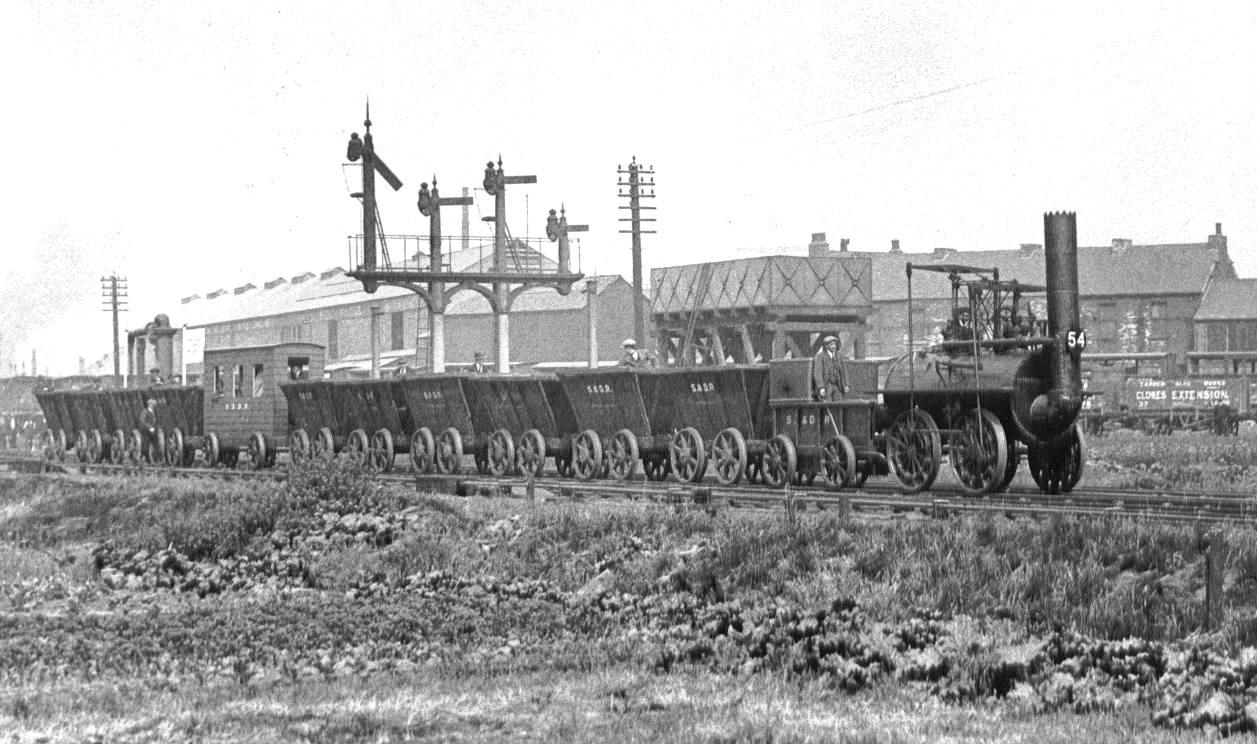 As part of the Stockton and Darlington Railway Centenary Celebrations, on 1st July 1925 S&DR 'Locomotion' heads a recreation of one of the first trains, as part of the parade. Photo: LCGB, now NRM, Ken Nunn collection
As part of the Stockton and Darlington Railway Centenary Celebrations, on 1st July 1925 S&DR 'Locomotion' heads a recreation of one of the first trains, as part of the parade. Photo: LCGB, now NRM, Ken Nunn collection
2nd April 2024: A Two Parter, by two of our Local Supporters
The Smallford Station Project
First off was Alastair Cameron with an informative talk on how to save and open to the public the remains of a local railway station - with support from the local council and much volunteer time, both young and old, a great deal can be achieved. The station in question is Smallford, which was a simple roadside station on a single line route, the St Albans to Hatfield line of the GNR, opened in 1866 and closed to passengers in 1951 and freight in 1965. The line has become a walking and cycling route. A supporter’s group was formed partly inspired by a local postman who had single handedly restored a nearby halt at Nast Hyde. Volunteers have cleaned up the platform and put in lamps and seats. There is a small car park and opportunities for food and interpretation via the retired goods van soon to be installed enabling the group to display some of its relics collection some of which were dug up locally including a lump of Barnsley coal much coveted by the GN for its engines. There have been opportunities for local youngsters to help with excavations and artwork. Alastair showed a range of photographs and there was an opportunity for discussion after, which produced a lively exchange. Branch sporters were obviously pleased to learn more of a local project so we wish them well and thanked Alastair. Details if the project can be found at https://smallford.org/smallford-station/.
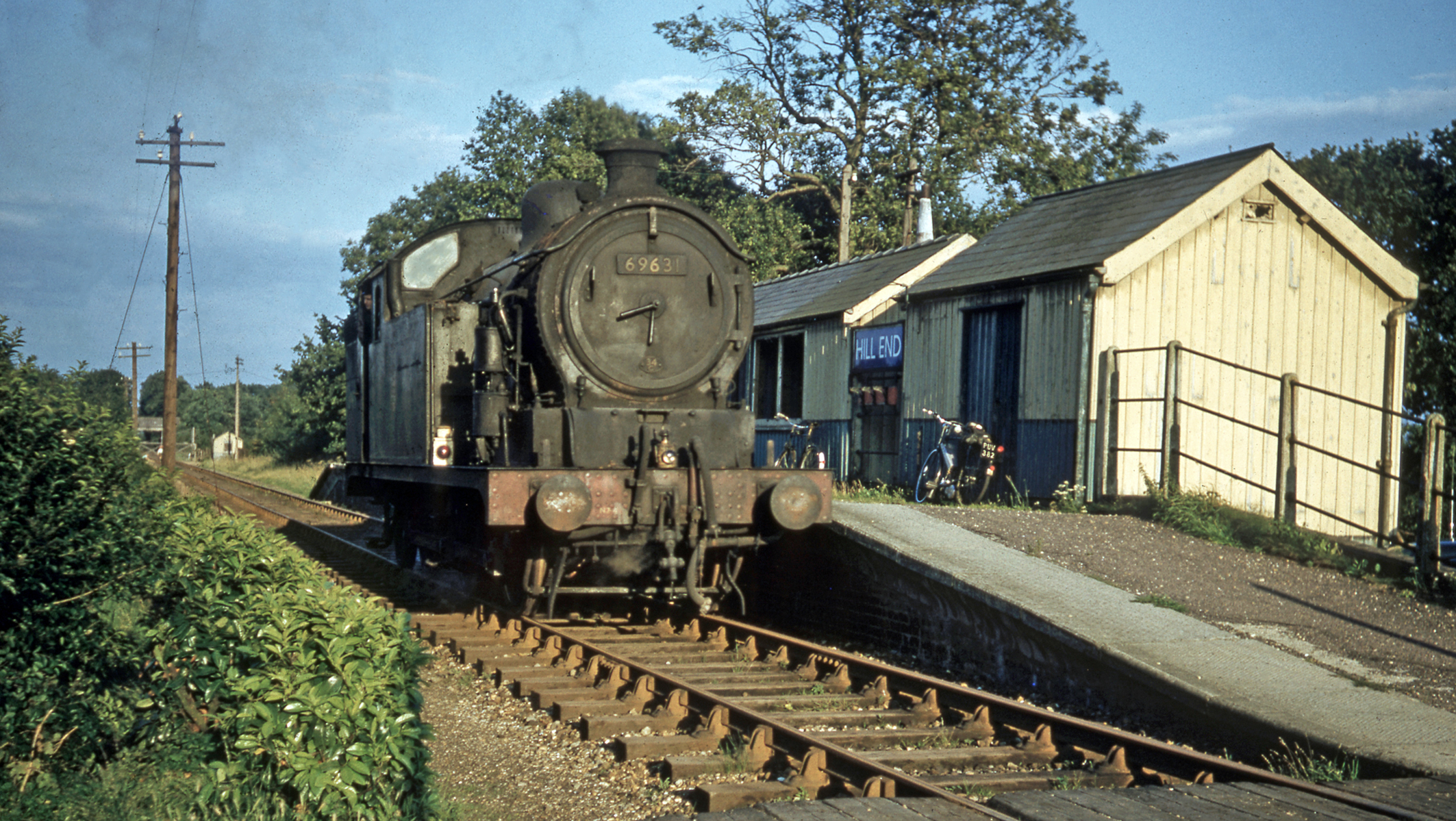
69631 passing Hill End - the next satation along the line - as the 6.10pm Hatfield to Salvation Army Sidings light engine on 28th August 1056. On its way to pick up the ‘The War Cry’ magazine and other publications from the Salvation Army sidings. Photo Peter Bland
Oxford to Cambridge
Next up off the bench for the second half was local rail expert Richard Crane who took us along the route of the Oxford to Cambridge Railway, showing how the line has changed over its long history featuring closure and resurgence. Starting at Oxford Rewly Rd terminus which like other line structures lives on in preservation. The route towards Bletchley featured stations, some closed and others reopening as part of East West Rail. We saw how Chiltern Trains had transformed part of the route when opening up from Marylebone to Oxford and Chris Green was praised on this occasion as on many others during the talk. What would we have done without him and the late Adrian Shooter. It seemed under Green anything was possible in the way of special trains. By way of the HS2 interchange now ready to go or “some day after a while” (john Mayall)! I was pleased to see that the box at Claydon lives on in preservation as in a photo with me on the track — Don’t try this today!
At Bletchley we heard about specials and the changes to motive power not forgetting the Flyover. Richard was on home ground towards Bedford where the car train passed (It’s going past as I write these notes). The problems of east/west were again aired between shots of the stations on the route with arrival at Bedford St John’s. We dashed on towards Cambridge especially enjoying shots of the last remnant of Cap’n Peel’s little line with its listed loco shed lurking in a Potton ex market gardener’s yard for all to see. At Old North Rd Station, the last but one stop before Cambridge was reached, an amazing restoration has taken place. Look it up and look out for an open day. Thanks to Richard for another well-planned tour of a much-missed line which will yet rise in some form from the ashes. (CHJ)
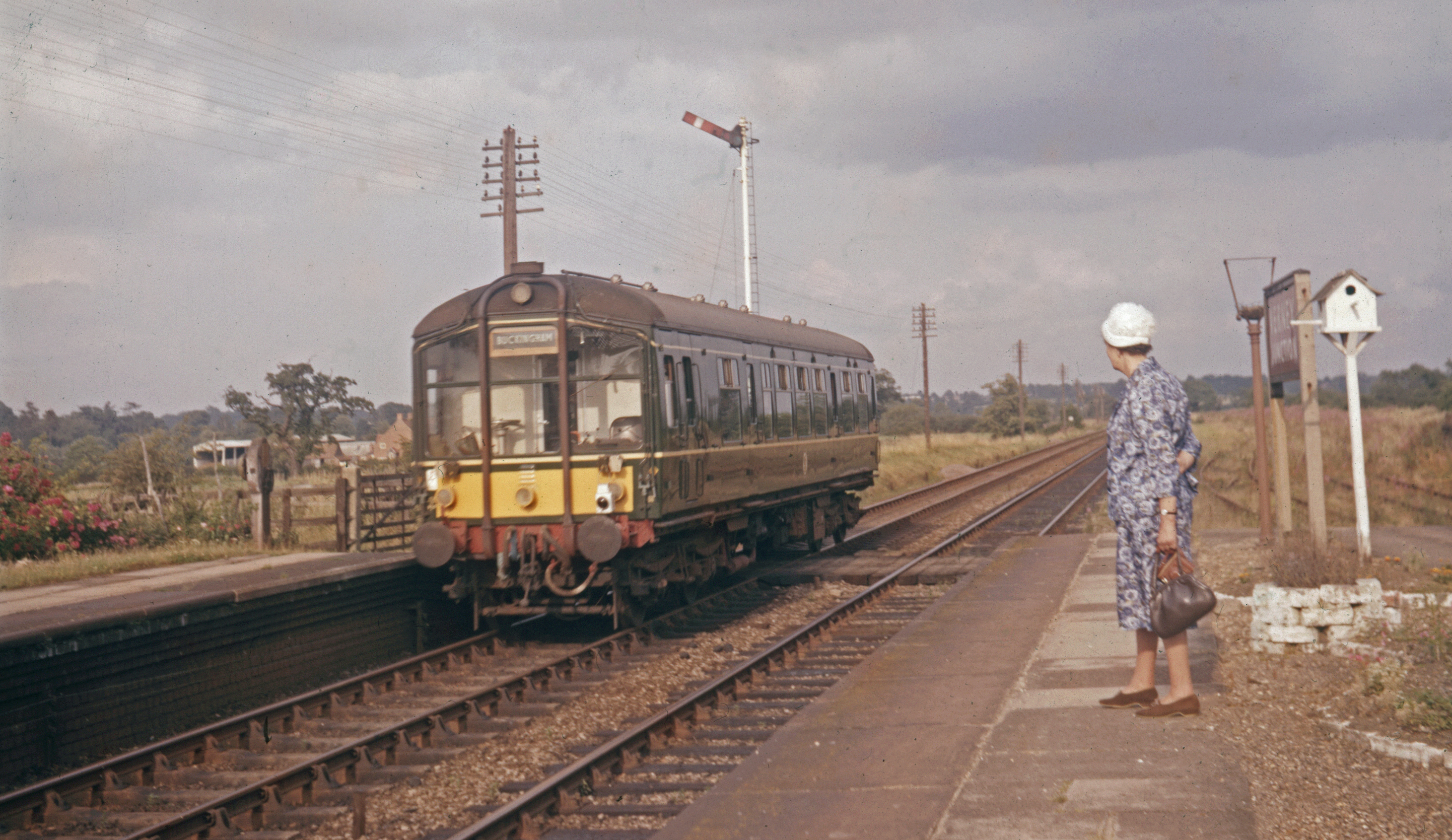
Mabel Clements looks on as M79900, one of the two Derby Built Single Unit Motor Brake Seconds, leaves Verney Junction on a Buckingham to Bletchley working in the early 1960s. Photo: Harold Clements.
5th March 2024: An 11th Colour Rail Journey - Paul Chancellor
How grateful we are for the work being done to save such a valuable asset as railway history in mostly colour slides but also B and W prints. As their site says 148,806 images and growing. Old as well as modern traction so recording railway history as it happens.
Paul’s journey was mostly “1964 an interesting year”. This was when your scribe took up his hobby so the wait was worth it.
The journey was nationwide showing the shear range on offer to just view or purchase for you own use or in my case to embellish talks. Not only but also all those liveries garish among them that we had forgotten or are trying to forget
1964 and what a year it was with rails ripped up on line closures in a bad year as I well remember in South Wales
It was also the era of the enthusiast tour where in those halcyon days we detrained onto the ballast in our thousands to wander and photograph at will as our train waited by a sleeper placed across the far end of a decaying branch line. So, we were treated to many tour views.
The whole show just exuded variety from traction to liveries to settings
It was truly a tour of Britain starting in Penzance and ending in Banff with its curious terminal building. There were DMU’s of all hues and Paul covered all forms of these and EMUs on the tour. Steam was not neglected even if most machines were getting rather run down by then. So, we saw a Grange at Oxford, a contrast of grubby Class 56’s at Dowlais Cae Harris and 02’s on The Isle of Wight
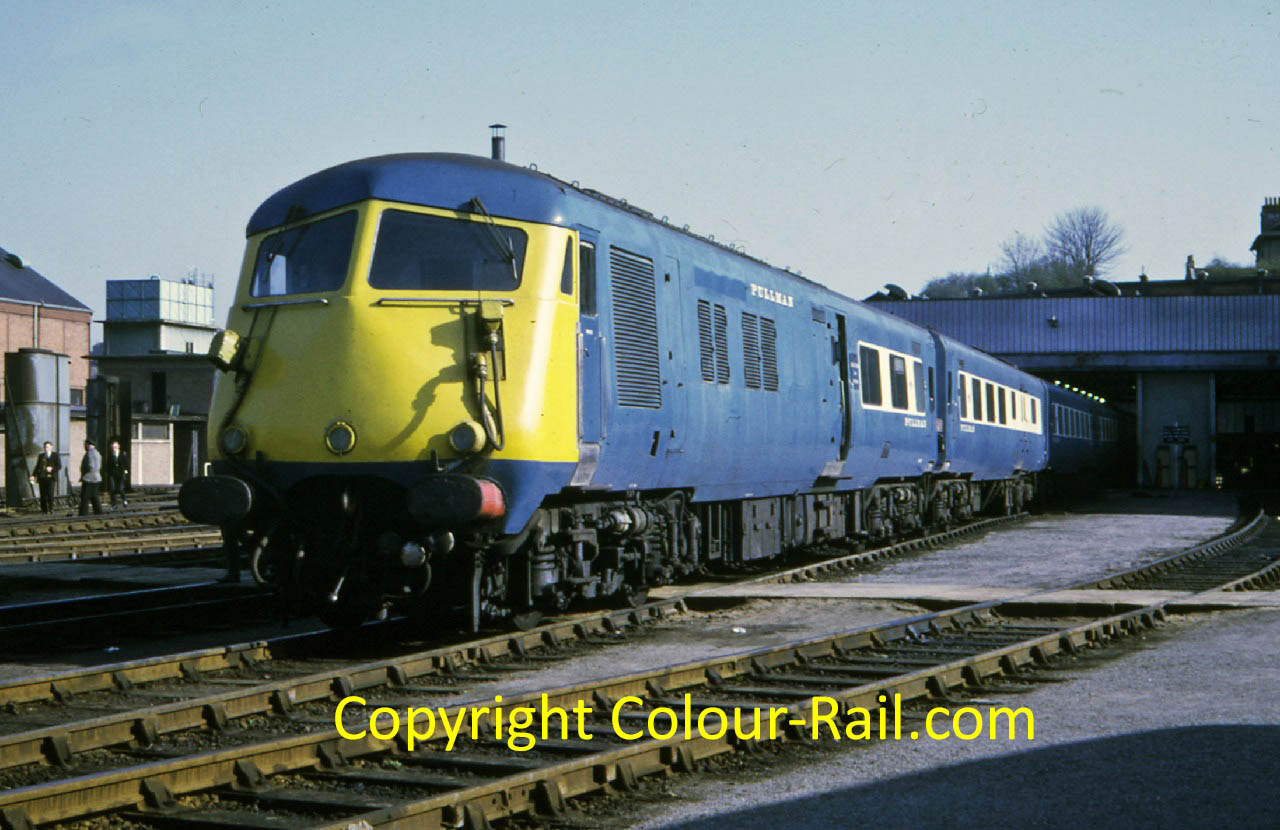
'Blue Pullman' unit at Bristol Bath Road depot. 129 Colour Rail - Image courtesey and copyright Colour-Rail.com
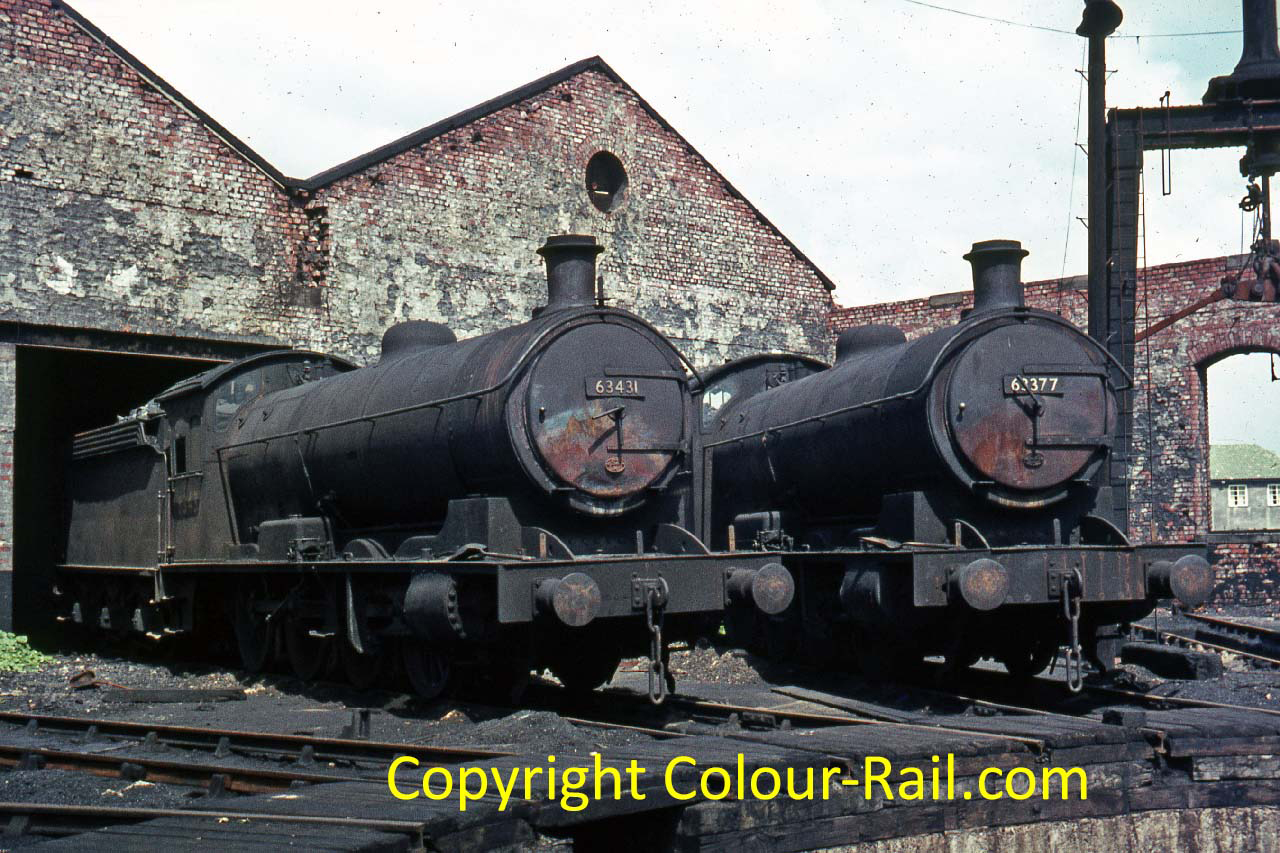
Ex NER Q6 0-8-0s at Tyne Dock 459 Colour Rail - Image courtesey and copyright Colour-Rail.com
Odd one of or twos of shunters were included in strange mysterious depots like S169 in Yeovil sleeper depot. Or The Pug at Neath probably as it attempted to get to Swansea Docks
In London we saw assorted steam and electric traction including even an “ugly” Q.
We romped on up Britain by way of Leamington over to Holyhead and east to Saltney. Up the hills to Parsley Hay and it seems no part had been missed on the tour from highlands to lowlands and collections praised for their diversity and the foresight of the many collectors who have given their work to Colorail so the journey can continue
My favourites—sea sun and sand at North Blythe with a Q6 and a B3 at Sunderland
The journey ended with a selection of traction that had survived the cutters torch and can now be enjoyed on main line or heritage sights
We hope Paul will be back to share more memories on a 12th journey (CHJ 12/03/24)
6th February 2024: Blue is the Colour - Richard Crane
With apologies to football fans, well Mr Crane especially. Richard can always come up with those missing railway topics which can turn a sow’s ear into a silk purse. Despite his warnings that we would doze off or need matchsticks to prop our eyes open I detected no such malaise in our audience. It was enlightening and instructive to remember an era that is passed but has recently been creeping back. Wall to wall blue was the order of the day as we moved through the traction classes. Richard as usual had thoroughly researched his topic and left no stone unturned. Starting with XP64 from 1964 he revived our corporate memories. Steam at least as liveries were concerned had mostly had its day so it was a brief look a Caley colour and some LNER stuff.

LNER A4 4468 Mallard at NRM, York - Image courtesy Richard Crane
So on via the new Pullmans and even blue Sealink to entering the world of diesel classes from 01 on to infinity class 45 saving the best until last perhaps from that blue era.

Class 45 (D) 97 at Flitwick - Image Courtesy Richard Crane
All were described though some are best glossed over. So as not to offend supporters do book Mr Crane for your next talk so you can challenge him on his views of the disgraceful reputation of some classes and the well-deserved reputation of others. His own and others pictures were featured and we saw Cl 27 and 28 featured at Bedford.
In my case a Cl37 glimpsed and heard toiling up a Welsh valley is my desert Island locomotive.
What was clear from his talk was that the plethora of unnecessary classes was an outdated desire to provide often freight shunting and class 8 goods workhorses for a traffic that was about to fall off a cliff. Even “super Shunters all 3 of them. Then there was the Western region and its isolationist policy regarding Hydraulics. All good stuff and enjoyable.
Things continued with Electric locos and electro diesels of which many less were built and so a good percentage are still at work. The preserved last 4VEP looks splendid in its new livery but as yet unable to move under its own power.
Moving away from the blue era “Sectorisation” produced some interesting liveries and we looked at several examples some attractive others less so.
Moving nearer to today blue has been creeping back via Scotrail and Pendolinos. The Lumo looked striking DRS got my blessing and a CL88 at Chester looked good.
A final flush of blue steam repaints brought us back to earth.
Richard is to be relied upon to give us a thoughtful evening with the audience wide awake throughout. (CHJ 08/02/24)
2nd January 2024: Nothing Stays the Same - Mike Corbett
The branch welcomed a new speaker Mr Mike Corbett. He had a 50-year career as a railwayman mostly in depot and works management. He was a senior engineering manager at Wolverton works when he retired. He describes himself as a people man so most of his pictures featured works colleagues and visitors. It was refreshing to see groups of smiling teams all getting on with running the railway in its various guises. Mike went as an engineering graduate to Crewe in the late 1960’s just missing out on the steam era. He began in an era with no or early “clunky” computers. He still attends the annual Crewe works dinner the longest running Railway dinner started in 1884. However, he did get to star with a champion of the steam age when he was project manager for the restoration of Flying Scotsman to main line running in 2016 for the NRM.
Mike spent time at Finsbury Park looking after the racehorses of the east Coast mainline—The legendary Deltics. People pictures featured including one of railway and “top Shed” sage Peter Townsend. Things followed by time in the Liverpool Street Division with a yellow van. Here he met legends like Bill Harvey.
We were amused by the sight and story of a Cl 47 being used to support the ailing CEGB generating system at West Thurrock for a while and of course being up on blocks.
He spent a good deal of time helping to set up the new Diesel depot known as “Crown Point” near Norwich. In an awkward spot and difficult to operate it was a success but not after he showed us disparaging cartoons from the local press about late trains etc. The depot carried out many wheel set jobs each year.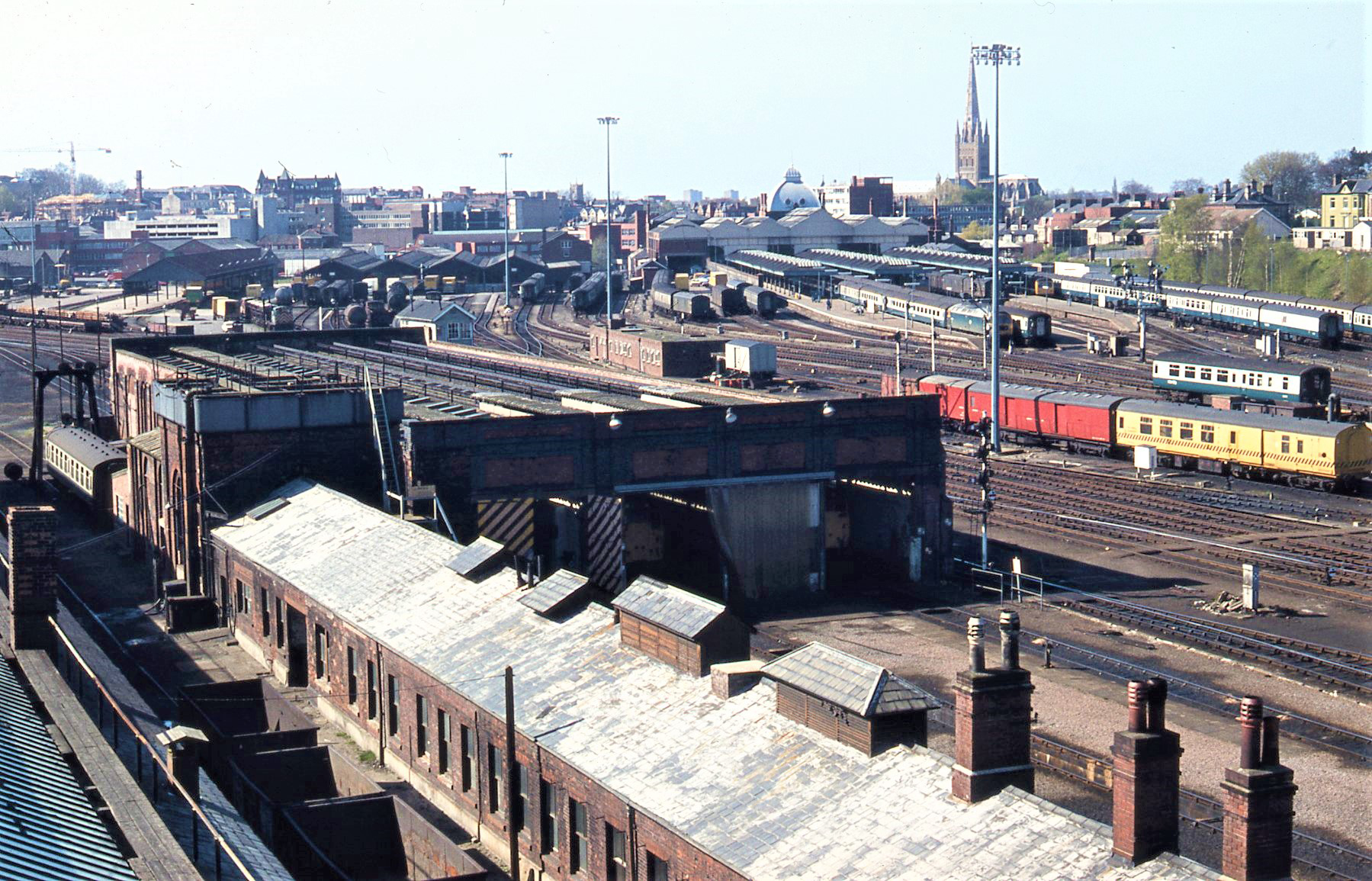
Norwich Crown Point - Image courtesy Mike Corbett
He then went to Chart Leacon NSE depot in the 1990’s managing 600 staff. More bogie changes and electric circuit works. Pictures included a certain M Bentine who we all failed to recognise. The Christmas card had even been saved for posterity.
Opened by Sir Peter Parker who featured in photos along with other photos of staff and visitors. Open days of the old fashion type where in a range of pictures along with visiting celebrities like Toya Wilcox and Steve Bruce. We are grateful that Mike got his camera out and captured these scenes. He even went to France on an exchange with engineering graduates.
Mike finally moved to Wolverton opened in 1838 and still going-just. He was innovative in recording paper and aural archives. More pictures followed even of the annual sports day and the offices. His involvement with safety improvements was noted including “toolbox talks!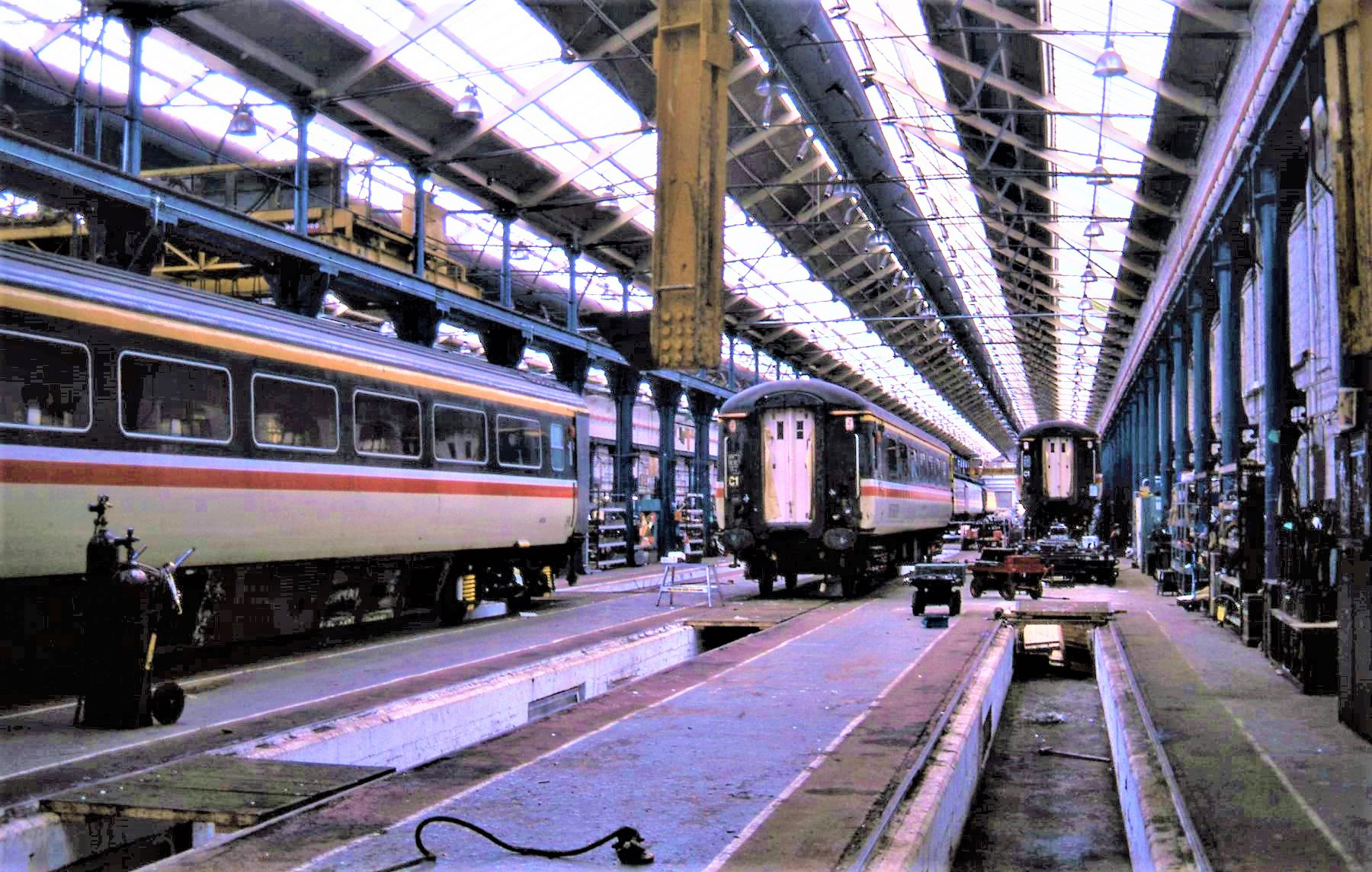
The lift shop Wolverton Works - Image courtesy Mike Corbett
We saw a model engine made by apprentices and now in MK museum and Mike also saved the alternator testers now on the SVR.
Finally, we heard about and saw his connection with The Royal Train.
This was a very rewarding illustrated talk with many anecdotes including shots of those much-enjoyed open days that used to happen. This all showing that we must not forget that the railway is still run by well-trained and caring people and so we look to a further visit and the sight of more saved images of long retired rail workers. (CHJ 14/01/24)
